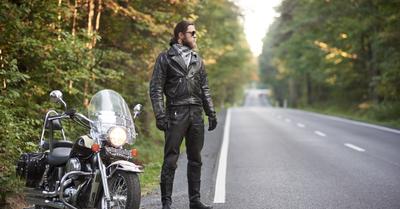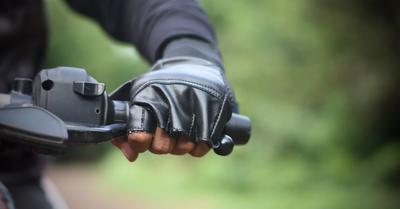How Does ABS work?
A Brief History
Anti-Lock Braking Systems were originally designed in the 1920s for aircraft to prevent tire blow-ups from pilots smashing on the brakes during landings. By the 1950s they were widely used in the UK aircraft improving the standard hydraulic brakes by 30% in ice, snow, and rain. In the 1970s they were a luxury add-on item for American high-end cars, and in 1988, the motorcycle world caught up with BMW installing them on their new K100. Finally, after most brands were already offering this piece of safety equipment, Harley-Davidson trotted out ABS on their Road King in 2008 for an $800 up-charge.
The Nuts and Bolts of ABS
When traveling over 4 MPH it is possible to lose control of your bike by squeezing the brake too hard, locking up your brakes, and experiencing a loss of steering control. Even at this low speed, dumping your bike can cause injury or at least injury to your ego. Imagine the deadly damage that can be done at 25 MPH or 55 MPH or speeds over 70 MPH. In the rain, snow, ice, oil slicks, or road debris, not to mention the unpredictable nature of other drivers, a tendency to panic and over-brake will cause the wheels to lock up resulting in a loss of steering and control of the bike. ABS measures the signals sent by a magnetic sensor from the wheel to the ECU (Electronic Control Unit) which determines if the brakes are about to lock up and prevent it. This happens by slightly decreasing the brake pressure allowing the wheels to continue spinning. The ECU adjusts in real-time up to 100 times a second then reapplies the brakes in a continually repeated action that takes place up to 10 times a second through rapid pulsing. This is faster and more controlled than most people’s reflexes, especially under the pressure of an accident or loss of control.
When ABS first entered the motorcycle market, riders didn’t like the feel of the brake technology, especially in their hand grip which strongly pulsed repeatedly. They also didn’t like the look of the extra wires, mechanisms, and weight. However, the technology has continued to improve, and the wires are now hidden, the weight reduced, and the brake experience smoothed out. Harley has added ReflexTM Linked Brakes along with their ABS which provides added stability and control linking the front and rear brakes over 25 MPH and are standard equipment on the Electra Glide Ultra Classic, the 2014 Street Glide Special, and Ultra Limited models and are optional on the Road King and Street Glides.
Which 2021-2022 Harleys Have ABS?
Because Harley-Davidson was one of the last bike manufacturers to include ABS on their new bikes in 2008, most older models do not have them. Fortunately, it’s an easy add-on. The wiring can be hidden fairly well, and the added weight is negligible averaging between 10 lbs and as little as the newer technology ABS at 1.5 lbs.
It’s important to remember that each brand’s ABS is unique to that brand. In other words, the Harley-Davidson ABS is created for Harley tires and wheels. Since the ABS is sensing rotational speed through wheel speed sensors, when that wheel or tire is changed to a different diameter, it will alter the rotational speed. Obviously, a larger tire spins slower and a smaller one faster. This can skew the calibration and prevent it from detecting and preventing wheel lockups. Tire pressure is also important as it will affect the computer system and the performance of the ABS.
The following Harleys have ABS standard:
- The Harley CVO Limited
- The Harley CVO Road Glide
- The Harley CVO Street Glide
- The Harley CVO Tri Glide
- The Harley Electra Glide Standard
- The Harley Electra Glide Ultra Classic
- The Harley Fat Bob 114
- The Harley Fat Boy 114
- The Harley Freewheeler
- The Harley Heritage Classic
- The Harley Heritage Classic 114
- The Harley LiveWire
- The Harley Low Rider S
- The Harley Road Glide
- The Harley Road Glide Limited
- The Harley Road Glide Special
- The Harley Road King
- The Harley Road King Special
- The Harley Sport Glide
- The Harley Street Glide
- The Harley Street Glide Special
- The Harley Tri Glide Ultra
- The Harley Ultra Limited
The following Harleys have ABS optional:
- The Harley Forty-Eight
- The Harley Iron 1200
- The Harley Iron 883
- The Harley Softail Slim
- The Harley Softail Standard
- Harley Street Bob 114
How Can You Tell If Your Harley Has ABS?
Because they’ve hidden it so well, it may be necessary to physically check and see if your bike is equipped with ABS especially if you bought it used.
- Instrument Panel: When you turn the key and your bike does its system check, the ABS light will illuminate. This only means that at one point the ABS was original to the bike; however, it could have been removed, so further investigation is warranted.
- Slotted Disc: Check for a round slotted disc that is bolted to the front axle in line with your disc brakes. It will look like a disc with a small diameter on it. Aftermarket kits will be bolted to the brake caliper and are the mechanism that pulses the brake to a stop.
- Follow Brake Lines: If your brake lines go directly to the caliper, you do not have ABS. However, even if the lines go into the chassis or a box, it could be connecting to a linked system or proportioning valve and still may not be ABS.
- Owner’s Manual: If buying new, check your owner’s manual to see if your bike includes ABS. Call the number included with your bike’s VIN to make sure.
- Service Station: For less experienced bikers, stop by your trusted mechanic or Harley-Davidson authorized service representative to authenticate your ABS.
Final Warning About Harleys and ABS
When Harley-Davidson first caught up with other brands and offered ABS in 2008, it was new technology for the iconic manufacturer and mistakes might have been made. A class-action lawsuit in California claims that the wiring harness was not strong enough for normal wear and tear or left and right steering movement causing the wiring to fail. When this happened, it was impossible to know if the ABS failed and in an emergency, wheel lockup could occur. Normal foundational braking would still exist but because the operator engages in two different styles of braking with ABS vs. Foundational, an accident was more likely. The lawsuit alleges that Harley knew about this defect but did not recall the affected motorcycles. In 2011, the wiring harness was improved and strengthened. However, if you own a Touring or CVO Touring model of Harley from 2008 – 2010, you should have your wiring harness replaced on your ABS.















